As the organizations change infrastructure and applications into the cloud, the new high point of strong security measures has finally arrived. The land of cloud security has changed in 2024 and now offers accurate, sophisticated tools available for use in fighting ever-increasingly complex cyber threats.
This most important article talks about the list of cloud security tools to ensure the cloud environment is secure.
What are Cloud Security Tools?
Cloud security services can be described as the specialized type of software that is meant for protection of cloud infrastructure, applications, and data against all types of threats. These tools provides capability based on comprehensive security, including features such as the detection of threat, vulnerability assessment, compliance monitoring, and incident response.
By 2025, the tools are more advanced with the implementation of artificial intelligence and machine learning to provide a predictive measure of security with automatic responses toward threats.
Why Do We Need Cloud Security Solutions?
There are many challenges that ensure the security of deploying applications and services speedily. Cloud security solutions offer a framework for the employment of security measures without risking agility and efficiency. They allow teams to automate several security processes so that they retain compliance and protect against evolving threats while retaining their development velocity.
Key reasons why we need cloud security solutions:
- Security: The Security tools keep pace with and maintain security at every point and be compatible with automated deployment pipelines.
- Compliance and Governance: With best cloud security tools, organizations are able to fulfill internal governance requirements as well as external compliance through automated monitoring and reporting.
- Multi-Cloud Environment Security: Due to the fact that many organizations have adopted multi-cloud strategies, tools offering security across various cloud providers along with various environments provide integrated protection.
Suggested Read: Competitor Analysis Tools to Spy on Your Competition
Types of Cloud Security Services
1. Cloud Infrastructure Security Platforms
The broad cloud security solutions that offer end-to-end security for the infrastructure of the cloud are listed below:
- Snyk
- Prisma Cloud
- Aqua Security
Main Features:
- Cloud workload protection
- Container security
- Scanning for serverless security
- Cloud configuration management
2. Cloud Access Security Brokers (CASBs)
CASB stands for the security policy enforcement point between the consumers of the cloud service and providers. CASB includes,
- Microsoft Defender for Cloud Apps
- Netskope
- Zscaler
Main Features:
- Visibility into use of the cloud service
- Data Security and Compliance
- Threat Protection
- Access Control
3. Cloud Security Posture Management (CSPM)
The risk visualizations and assessments concern CSPM tools are:
- Wiz
- Orca Security
- CloudGuard
Main Features:
- Continuous Security assessment
- Compliance monitoring
- Risk visualization
- Automated remediation recommendation
4. Container Security Solutions
Tools to be used for the protection of containerized applications:
- Trivy
- Anchore
- Qualys Container Security
Main Features:
- Container image scanning
- Runtime protection
- Kubernetes security
- Vulnerability management
5. Identity and Access Management (IAM)
IAM tools are aimed at managing user identities with their access rights as follows:
- Okta
- Microsoft Azure Active Directory
- Amazon Web Services IAM
Main Features
- Multi-factor authentication
- Single sign-on
- Privileged access management
- Access governance
Selecting a Cloud Security Tool for yourself
While selecting cloud security tools look for these things:
1. Integration Capabilities
- Easy integration
- Multi-Cloud Support
- APIs for Custom Integrations Available
2. Automation Capabilities
- Automated Security Testing and Scanning
- Remediation capability ends
- CI/CD Integration Pipelines
3. Compliance
- Compliance Templates integrated into the product
- Automatic reporting of compliance
- Compliance requirements updated by the company
4. Cost Efficiency
- Pricing is tiered to the size of an organization
- Measurable ROI
- Scalable pricing
Top 12 Cloud Security Tools for 2024
1. Bitglass: Total Cloud Security (Now Forcepoint)
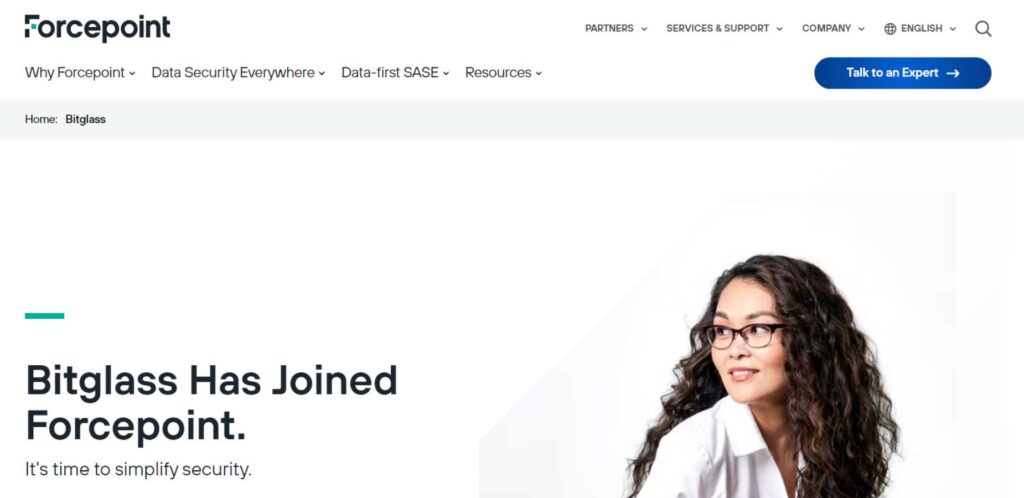
Bitglass’s innovative Zero Trust SASE platform is offering the most open source cloud security tools with real-time data and threat protection for any app, device, or location. Multiple security services, namely CASB, SWG, and ZTNA, in the Bitglass platform allow granular control of organization’s cloud resources and data. For Bitglass, its advanced technology detects threats and responds in real time with the use of machine learning algorithms.
However, it ensures sensitive data remains safe if it either resides at rest or is in transit. With patented AJAX-VM technology, a BYOD can be secured without an agent as well as the installation of any software.
Key Features
- Zero-day threat protection
- It provides functions for both CASB and cloud DLP.
- Smart Core as well as Smart Edge technology.
- Real-time protection against data and threats
- Agentless mobile security
Pros
- Deployment and management are straightforward
- Insight into all cloud applications
- Great protection and security of data
- Superb performance and scalability
- Compliance reporting is robust
Website
www.forcepoint.com/bitglass
2. SpectralOps
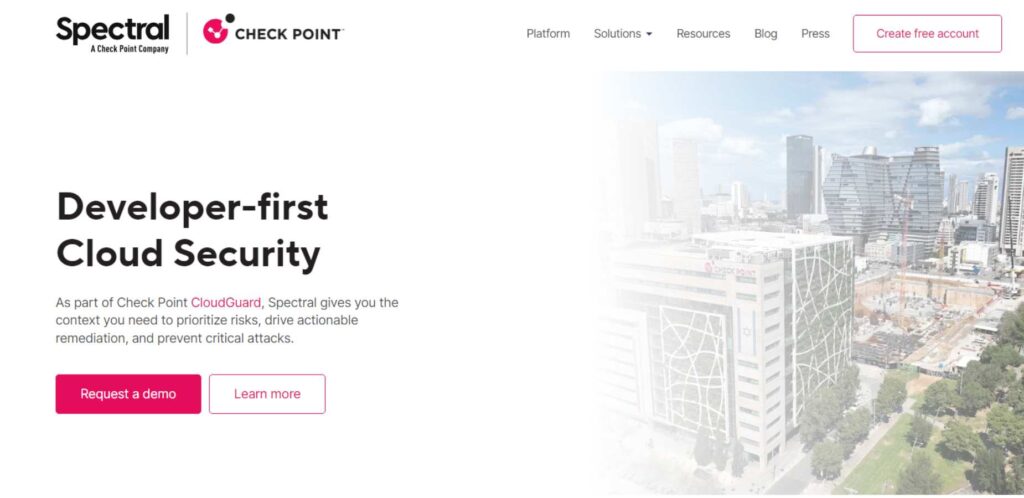
SpectralOps is one of the cloud security tools designed for developers to detect and prevent costly security mistakes in code and other assets. It finds exposed API keys, tokens, credentials, and other security risks across all assets and repositories by using AI/ML-powered scanning capabilities.
It can inform the developers, real-time on which of the security issues it contains in the repository, CI/CD pipeline, gists, and cloud assets. Their service is unique as it can protect JSON, yaml files as well as any source code.
Key Features
- AI-based secret detection
- Security of the code will be scanned in real-time
- Security of infrastructure-as-code
- API security monitoring
- Remediation of bugs through automated means
Pros
- Developer-friendly interface
- Low false positives
- Scan everything in record time
- Include everything
- Work with the workflows
Website
www.spectralops.io
3. Security Code Scan

Security Code Scan is one of the open-source cloud security tools and static code analysis tools, optimized for .NET. The analyzer performs a deep analysis of the source code to point out possible security vulnerabilities and coding mistakes which might appear sooner or later as vulnerabilities in the code. This works pretty nice with other popular IDEs, and also may be integrated into CI/CD pipelines to automatically send it security testing.
The library uses many advanced techniques, like pattern matching, taint analysis, to identify injection flaws, cross-site scripting, and bad implementations of insecure cryptography.
Key Features:
- Static code analysis of .NET Possible integration with popular IDEs
- Customizable security rules Integration with your CI/CD pipeline
- Detailed reporting of vulnerabilities
Pros:
- Free and open-source.
- It has regular updates and community support. Low false-positive rate.
- The integration into the developer’s workflow is effortless.
- Comprehensive vulnerability detection
Website
www.security-code-scan.github.io/
4. Cisco Systems Cloudlock

Cisco Cloudlock provides an integrated CASB functionality that lets you have complete visibility into and control of your cloud services. It is phenomenal in protecting the organizations against cloud-based risks with advanced capabilities in User and Entity Behavior Analytics (UEBA). Cloudlock approaches cloud security with a focus on securing users, data and applications across any cloud platform- SaaS, PaaS, and IaaS environments.
The solution gives an organization the deep visibility into the usage of cloud applications and keeps the organization compliant with a wide range of regulatory requirements.
Key Features
- Cloud Data Loss Prevention (DLP)
- User and Entity Behavior Analytics
- App discovery and control
- Compliance monitoring
- Cross-platform threat protection
Pros
- Very good integration capabilities
- Full visibility
- Sophisticated threat detection
- Very good compliance features
- User-friendly interface
Website
www.cisco.com/c/en/us/products/security/cloudlock
5. Perimeter 81
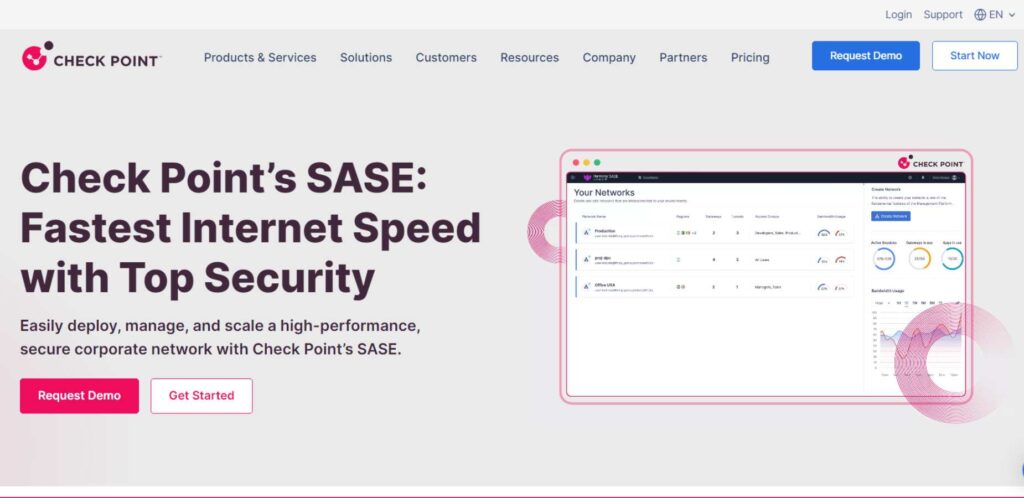
Perimeter 81 provides a holistic Zero Trust Network as a Service (NaaS) solution, thereby making traditional network security a cloud-based service. It is a hybrid SDP-based solution that offers the advanced network security feature of safe access to any organizations’ resources from anywhere.
Its approach nullifies the need for hardware-based traditional VPN but offers superior security with the facility of identity-based access control. It is feature-rich in advanced network segmentation, activity auditing, and automated policy enforcement. It stands to be one of the perfect solutions for organizations embracing the concept of remote work and cloud-first strategies.
Key Features
- Zero Trust Network Access (ZTNA)
- Firewall that is cloud-based
- Network segmentation
- Activity monitoring and auditing
- Automated Policy Enforcement
Pros
- Easy to deploy and manage
- Scalable architecture
- Good security features
- Excellent performance
- Cost-effective solution
Website
www.perimeter81.com
6. Illumio Core
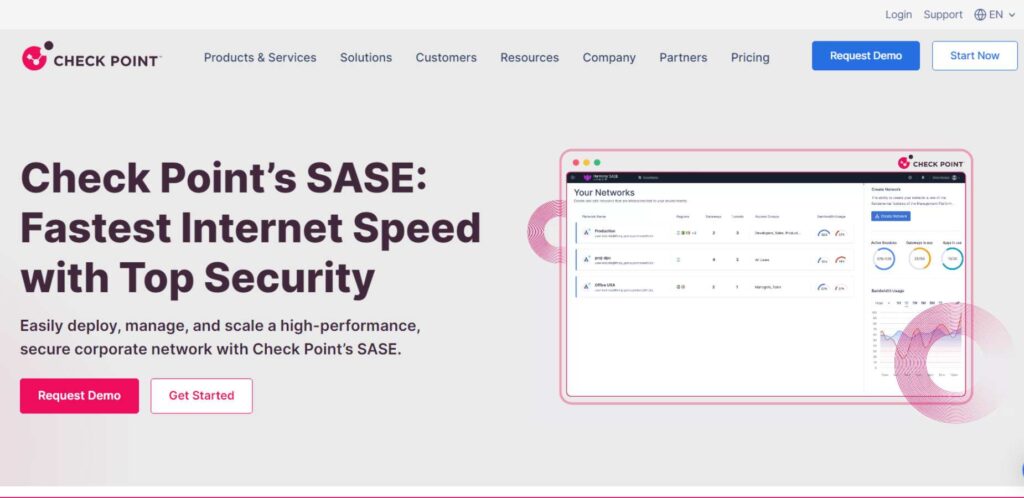
Illumio Core is the revolutionary pathfinder. It is one of the cloud security tools that offers real-time security of workloads in any data center or cloud environment. The zero-trust by segmentation approach introduced by the platform prevents threats from the lateral movement hybrid cloud infrastructures. It offers unparalleled visibility to workload communications, providing real-time application dependency mapping to assist the security teams in understanding and controlling interactions of applications.
This technology automatically adjusts to changes in environmental conditions and alters security policies, thus offering protection every moment of the way.
Key Features
- Real-time application dependency mapping
- Adaptive micro-segmentation
- Controls based on policy for security
- Multi-cloud workload protection
- Visual security analytics
Pros
- Implementation can be smooth with no changes in the network
- Delivers great visibility over the dependencies of the application
- Offers flexible management of policies
- It develops robust compliance with regulations
- It offers intuitive visualization capabilities.
Website
www.illumio.com/products/core
7. Orca Security

One of the cloud security tools called SideScanningTM from Orca Security gives full visibility within the environments of Azure, and GCP in a completely agentless way. Orca offers full security coverage across the layers of compute, storage, networking, and identity in cloud environments. In as little as minutes, Orca can identify vulnerabilities, malware, misconfigurations, lateral movement risks, authentication risks, and exposure of sensitive data.
That brings it a notch higher since it will allow it to prioritize risks based on environmental context, accessibility, and business impact so that its solution can be utilized by security teams focusing on only the issues of import.
Key Features
- Agentless cloud security scanning
- Full-stack visibility
- Contextual risk prioritization
- Compliance monitoring
- Asset inventory management
Pros
- Zero performance impact
- Super-fast deployment
- Holistic risk assessment
- Good prioritization capabilities
- Compliant reporting
Website
https://orca.security
8. XM Cyber

XM Cyber brings the most advanced BAS platform that continually exposes attack vectors from breach points to organizational critical assets. Automated purple team, which allows organizations to simulate real-world attacks, identify gaps in security, and remediate before they’re actually exploited. The combined risk analytics, along with the attack simulation, make this product unique in providing actionable insights for enhancement in security posture.
The solution is continuously monitoring the security environment, providing real-time visibility into potential attack paths and prioritizing the remediation efforts based on business impact.
Key Features:
- Automated purple team exercises
- Attack path visualization
- Risk-based remediation prioritization
- Continuous security validation
- Impact-based analytics
Pros
- Sophisticated capabilities for attack simulation
- Remediation guidance
- Full risk assessment
- Real-time monitoring
- Business context aware
Website
www.xmcyber.com
9. Fugue (now Snyk)

Fugue is one of the comprehensive cloud security tools and compliance solutions that includes cloud infrastructure environments. It employs continuous configuration monitoring, policy enforcement, and other types of automated remediations that are cross-platform; that include AWS, Azure, and Google Cloud.
This it does by taking the infrastructure as code approach to ensure that a company’s cloud environment is safe and compliant in the long run. Solution automatically detects and corrects cloud infrastructure misconfigurations resulting in breaches of data and compliance.
Key Features
- Infrastructure cloud security posture management
- Automated policy enforcement through configuration
- drift detection and compliance automation
- Infrastructure visualization
Pros
- Advanced automation capabilities
- Provides 100% coverage for compliance
- Continuous tracking of configurations
- User interface ease of navigation
- Fantastic visualization tools
Website:
https://snyk.io/product
10. Cato Networks | Cato SASE
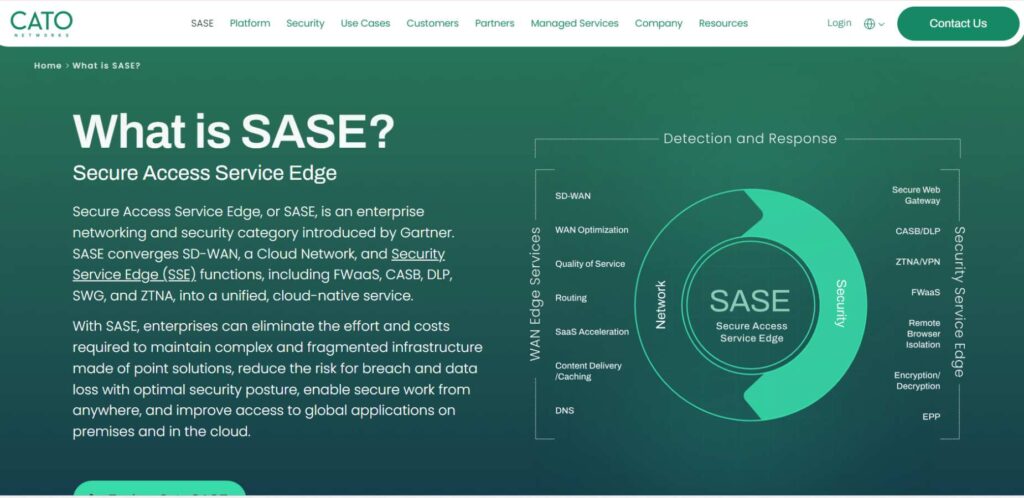
Cato Networks is an all- Secure Access Service Edge -converging SD-WAN and network security into a global, cloud-native service. The platform provides enterprises with a full networking and security stack as a cloud service, so they will never have to buy multiple point solutions.
All traffic is optimally routed to the global private backbone of Cato, in order to give secure and optimized access to applications and resources without a particular location. Advanced security capabilities of NGFW, IPS, and SWG are managed through a single pane of glass by the solution provided by Cato.
Key Features
- Global private backbone
- Network Zero trust access
- Cloud native firewall
- Secure remote access
- Advanced threat prevention
- Advantage Single unified platform
- Global network coverage
Pros
- User Ease of Management
- Excellent performance
- A cost-effective solution
Website
https://www.catonetworks.com/sase
11. C3M – Cloud Infrastructure Entitlement Management (CIEM)
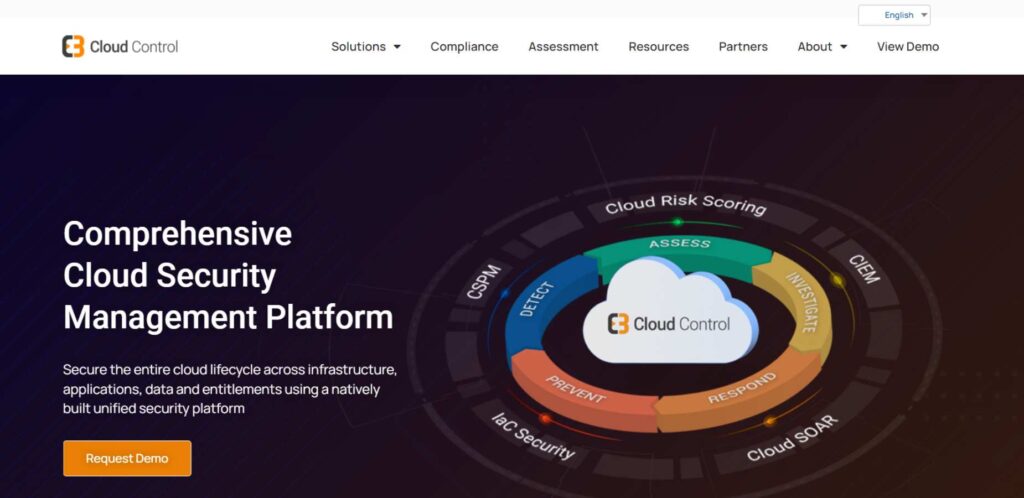
C3M developed an advanced CIEM solution that addresses some of the most challenging issues within cloud access management and permissions. The platform makes it possible to have an end-to-end view into IAM configurations, and thus organizations can identify and fix over-permissioning, also remediate the risk. C3M’s analytics engine will watch the cloud environments for security issues related to identity violations as well as compliance violations, privilege escalations.
Key Features
- Multi-cloud IAM governance
- Privilege right-sizing
- Access risk assessment
- Compliance monitoring
- Automated remediation
Pros
- Max entitlement visibility
- Strat compliance capabilities
- Automated risk remediation
- User-friendly interface
- Detailed reporting
Website
www.c3m.io
12. OpenVAS

OpenVAS (Open Vulnerability Assessment System) is a comprehensive open-source framework for vulnerability scanning and management. It is widely used by security professionals to identify and assess security vulnerabilities in various systems, networks, and applications.
OpenVAS offers a range of tools and services, including automated scanning, detailed reporting, and continuous updates to its vulnerability database, making it a valuable asset for maintaining robust security postures.
Key Features
- Extensive Vulnerability Database
- Advanced Scanning Capabilities
- Detailed Reporting and Analysis
- User-Friendly Interface
- Integration and Extensibility
Pros
- Cost-Effective
- Community Support
- Proactive Security Management
- Flexibility
- Network Security Audits
- Penetration Testing
Website
https://app.cloudknox.io
Cloud Security Best Practices
Cloud computing has now become a backbone of modern business operations. However, with growing use of cloud services, it also raises the critical issue of strong security measures. This all-inclusive guide reviews the key cloud security best practices to be implemented by the organization for protecting valuable digital assets.
Multi-Layer Approach to Security
The implementation of cloud security strategy would start through several controls’ embedding into the system. This will avoid a single point of failure, where in case one of the security controls fails, others will remain working to provide security. Several security devices and practices would be assimilated into the business model of the firm.
They include:
- Next generation firewalls as well as intrusion detection systems
- Security auditing and vulnerability assessment regularly
- Encryption of data while in transmission and storage
- Strong authentication mechanism
- Continuous monitoring and threat detection
Access Management and Identity Control
Access controls should also be strictly limited so that the security of the cloud is taut. There should be an embracing of the principle of least privilege-that of giving users only the minimum amount of resources needed to accomplish their task and see only what is necessary to do so. These considerations will include multi-factor authentication of all cloud services:
- Rights reviewed and modified at reasonable intervals,
- Strict password policies with regularly changed passwords,
- Use of Single Sign-On solutions that can facilitate central management of access.
Data Protection and Encryption
Data needs to be at the heart of any cloud security strategy. Organizations need to ensure that data enters safe custody either in motion or in rest in the following ways:
- Data in motion should receive end-to-end encryption
- Data must at rest be kept safe through strong encryption
- Regular backup and disaster recovery plan
- Data classification and handling procedures which are clear
- Compliance with any data protection legislation
Cloud Configuration and Monitoring
Configuration alone protects the system. Organizations should,
- Frequently audit the cloud configuration
- Detects unwanted changes
- Integration of automated security scanning
- Keeps very rich logs of all the activities going on in the clouds
- Use CSPM tools
Training of Employees and Security Awareness
Human factors still fall among the biggest risks. Organizations should invest in,
- Timely security awareness training
- Phishing exercises simulated
- Security policies and procedures
- Incident response plans updated with application
- Sustained security education programs
Management and Compliance with the Vendors
Organizations involved in the deployment with cloud service providers have to consider the following:
- Whether any security measures that the provider has undertaken.
- Whether the provider follows all the compliance standards of the concerned industry in adhering to such standards.
- The level of services offered should be reviewed from time to time to see if everything is in line with signed service level agreements.
- Security responsibilities among employees should be clearly defined.
- Third-party access and activity should be monitored.
Conclusion
Cloud security tools are not just a one-time implementation but a journey of constant vigil and adaptation. Organizations should open their eyes to the emergence of new threats and the ever-evolving practice of security. Through these best practices and proactivity about security, organizations can do so much better about protecting their cloud infrastructure and data against increasingly sophisticated cyber threats.
FAQs
What should be the most prominent first act in cloud security?
Typically the most critical first acts would be doing a broad security assessment of your existing cloud infrastructure and implementing access controls.
How frequently should security training be conducted?
Security awareness training should be performed at least quarterly.
Really do all the data in the cloud need to be encrypted?
Encryption is key to protecting information both at rest and in transit. It provides an essential layer of security even if other protective measures fail.
What is the biggest mistake about cloud security that organizations make?
Assuming that generally, cloud providers handle all security issues. Most fundamentally, though, security is a shared responsibility between provider and the organization.
